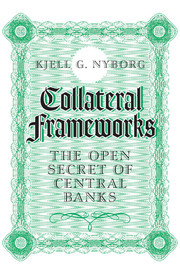Book contents
- Frontmatter
- Contents
- List of Figures
- List of Tables
- List of Exhibits
- List of Examples
- Preface
- Acknowledgments
- 1 Background and Motivation
- 2 Collateral Frameworks: Overview
- 3 Monetary Policy Implementation in the Euro Area over Time
- 4 Evidence on the Production and Usage of Collateral
- 5 Haircuts
- 6 Ratings and Guarantees
- 7 Market and Theoretical Prices
- 8 Collateral “Own Use”
- 9 Non-regulated Markets, Unsecured Bank Debt, and LTRO Uptake
- 10 Market Discipline
- 11 Bailing Out the Euro
- 12 The Endgame of the Euro Crisis
- 13 Restoring Credibility
- 14 The Problem with Collateral
- 15 Concluding Remarks
- Appendix: Haircut and Rating Rules Updates
- References
- Index
8 - Collateral “Own Use”
Published online by Cambridge University Press: 06 January 2017
- Frontmatter
- Contents
- List of Figures
- List of Tables
- List of Exhibits
- List of Examples
- Preface
- Acknowledgments
- 1 Background and Motivation
- 2 Collateral Frameworks: Overview
- 3 Monetary Policy Implementation in the Euro Area over Time
- 4 Evidence on the Production and Usage of Collateral
- 5 Haircuts
- 6 Ratings and Guarantees
- 7 Market and Theoretical Prices
- 8 Collateral “Own Use”
- 9 Non-regulated Markets, Unsecured Bank Debt, and LTRO Uptake
- 10 Market Discipline
- 11 Bailing Out the Euro
- 12 The Endgame of the Euro Crisis
- 13 Restoring Credibility
- 14 The Problem with Collateral
- 15 Concluding Remarks
- Appendix: Haircut and Rating Rules Updates
- References
- Index
Summary
“Own use” of collateral is the case that a counterparty uses collateral (in a Eurosystem operation) issued by itself or an entity with which it has “close links.” As defined in the official documentation, close links are said to exist between two parties, A and B, (i) if at least one of the parties owns or controls, directly or indirectly, 20 percent or more of the capital or voting rights of the other, or (ii) a third party owns or controls, directly or indirectly, the majority of the capital or voting rights of both A and B. As of January 1, 2007, this is refined to include issuers, debtors, and guarantors (ECB 2006/12). In October 2008, the trigger level with respect to the third party in (ii) is changed from “majority of the capital” to “more than 20% of the capital of the counterparty [using the collateral in a Eurosystem operation] and more than 20% of the capital of the issuer/debtor/guarantor, either directly or indirectly, through one or more undertakings” (ECB 2008/13). Own-use collateral is sometimes also referred to as “retained collateral” in the official documentation.
With respect to eligibility, the baseline rule is that:
Despite their inclusion in the tier one list, National Central Banks shall not accept as underlying assets debt instruments issued or guaranteed by the counterparty, or by any other entity with which the counterparty has close links.
ECB (2000/7, p. 33).While this would make own use of collateral impossible, there are and have always been exemptions to the baseline rule.
The exemptions are initially laid out in ECB (2000/7). Specifically, footnote 45 of this document states that the prohibition against own-use collateral does not apply to
1. “close links between the counterparty and the public authorities of EEA countries;” ECB (2003/16, footnote 52) adds the following parenthetic clause to this: “(including the case where the public authority is a guarantor of the issuer)”; ECB (2008/13) adds that the public authority acting as guarantor should have “the right to levy taxes” and
2. “debt instruments which comply strictly with the criteria set out in Article 22(4) of the UCITS Directive (Directive 88/220/EEC amending Directive 85/611/EEC)” or “cases in which debt instruments are protected by specific legal safeguards [that are] comparable.”
Information
- Type
- Chapter
- Information
- Collateral FrameworksThe Open Secret of Central Banks, pp. 168 - 170Publisher: Cambridge University PressPrint publication year: 2016
